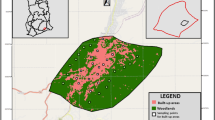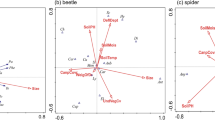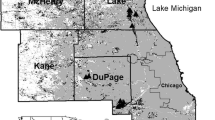Abstract
Urban densification is often considered has a green planning policy. However, its effects on woodland arthropods have been rarely analysed. To fill this gap, a multi-taxa approach using three ground-dwelling arthropod assemblages was conducted on 11 woodlands located along an urbanisation gradient. The gradient range from rural areas to one of the most urbanized cities in the world: Paris (France). Spiders, ground beetles and rove beetles were sampled with pitfall traps. We addressed the two following questions: (i) do the responses to urbanisation differ between taxa and/or between trait groups (habitat affinity to woodlands and dispersal capability) along the gradient? (ii) do the richness and abundance show a linear or an intermediate response? Our results showed a replacement of forest and non-flying species by generalist species and flying species with an increasing level of urbanisation. In term of species richness and abundance, the response varied between taxonomical and also trait groups. Some groups showed a strong linear decrease like forest carabids but other groups like spiders showed maximum values at intermediate levels of urbanisation. However, after a threshold of 70 % of built-in area, urbanisation negatively affected the species richness of all taxa and almost all trait groups, with a stronger effect on forest species. We suggest that the urban densification strongly impacted the assemblages of ground-dwelling arthropods by modifying both landscape and local properties of woodlands. To be considered as a green planning policy, the deleterious effects of urban densification should be mitigated.





Similar content being viewed by others
References
Ahern J (1995) Greenways as a planning strategy. Landsc Urban Plan 33(1–3):131–155
Alaruikka D, Kotze DJ, Matveinen K, Niemelä J (2002) Carabid beetle and spider assemblages along a forested urban-rural gradient in southern Finland. J Insect Conserv 6(4):195–206
Antrop M (2004) Landscape change and the urbanization process in Europe. Landsc Urban Plan 67(1–4):9–26
Bai X, Nath I, Capon A, Hasan N, Jaron D (2012) Health and wellbeing in the changing urban environment: complex challenges, scientific responses, and the way forward. Curr Opin Environ Sustain 4(4):465–472
Balkenhol B, Flisse J, Zucchi H (1991) Investigations into carabid beetles and spiders (Carabidae and Araneida) in an urban quarry—to the problem of habitat isolation. Pedobiologia 35(3):153–162
Bell JR, Bohan DA, Shaw EM, Weyman GS (2005) Ballooning dispersal using silk: world fauna, phylogenies, genetics and models. Bull Entomol Res 95(02):69–114. doi:10.1079/BER2004350
Bohac J (1999) Staphylinid beetles as bioindicators. Agric Ecosyst Environ 74(1–3):357–372
Boyko CT, Cooper R (2011) Clarifying and re-conceptualising density. Prog Plan 76(1):1–61. doi:10.1016/j.progress.2011.07.001
Burnham KP, Anderson DR (2002) Model selection and inference—a practical information-theoretic approach, 2nd edn. Springer, New York
Cardinale BJ, Duffy JE, Gonzalez A, Hooper DU, Perrings C, Venail P, Narwani A, Mace GM, Tilman D, Wardle DA (2012) Biodiversity loss and its impact on humanity. Nature 486(7401):59–67
Chapman JW, Reynolds DR, Smith AD, Riley JR, Telfer MG, Woiwod IP (2005) Mass aerial migration in the carabid beetle Notiophilus biguttatus. Ecol Entomol 30(3):264–272. doi:10.1111/j.0307-6946.2005.00702.x
Clergeau P, Jokimaki J, Snep R (2006) Using hierarchical levels for urban ecology. Trends Ecol Evol 21(12):660–661
Connell JH (1978) Diversity in tropical rain forests and coral reefs. Science 199(4335):1302–1310. doi:10.1126/science.199.4335.1302
Crawley MJ (2009) The R book. Wiley, Chicago
Croci S, Butet A, Georges A, Aguejdad R, Clergeau P (2008) Small urban woodlands as biodiversity conservation hot-spot: a multi-taxon approach. Landsc Ecol 23:1171–1186
Dallimer M, Tang Z, Bibby PR, Brindley P, Gaston KJ, Davies ZG (2011) Temporal changes in greenspace in a highly urbanized region. Biol Lett 7(5):763–766
Davies ZG, Fuller RA, Loram A, Irvine KN, Sims V, Gaston KJ (2009) A national scale inventory of resource provision for biodiversity within domestic gardens. Biol Conserv 142(4):761–771
Dearborn DC, Kark S (2010) Motivations for conserving urban biodiversity Motivaciones para Conservar la Biodiversidad Urbana. Conserv Biol 24(2):432–440
Deichsel R (2006) Species change in an urban setting—ground and rove beetles (Coleoptera:Carabidae and Staphylinidae) in Berlin. Urban Ecosyst 9(3):161–178
Derunkov AV (2005) Changes in species diversity of rove beetles (Coleoptera, Staphylinidae) depending on the age of pine plantations in Central Belarus. Russ J Ecol 36(4):277–284
Dreistadt SH, Dahlsten DL, Gordon WF (1990) Urban forests and insect ecology. Bioscience 40(3):192–198
EEA (2006) Urban sprawl in Europe. European Environment Agency, Luxembourg
Elek Z, Lövei GL (2007) Patterns in ground beetle (Coleoptera:Carabidae) assemblages along an urbanisation gradient in Denmark. Acta Oecol 32(1):104–111
Entling W, Schmidt MH, Bacher S, Brandl R, Nentwig W (2007) Niche properties of Central European spiders: shading, moisture and the evolution of the habitat niche. Glob Ecol Biogeogr 16(4):440–448
Freude H, Harde KW, Lohse GA (1964) Die Käfer Mitteleuropas. Band4. Staphylinidae I (Micropeplinae bis Tachyporinae). Goecke and Evers Verlag, Krefeld
Freude H, Harde KW, Lohse GA (1974) Die Käfer Mitteleuropas. Band 5. Staphylinidae II (Hypocyphtinae und Aleocharinae). Goecke and Evers Verlag, Krefeld
Fuller RA, Gaston KJ (2009) The scaling of green space coverage in European cities. Biol Lett 5(3):352–355. doi:10.1098/rsbl.2009.0010
Gibb H, Hochuli DF (2002) Habitat fragmentation in an urban environment: large and small fragments support different arthropod assemblages. Biol Conserv 106(1):91–100
Griffiths GJK, Winder L, Holland JM, Thomas CFG, Williams E (2007) The representation and functional composition of carabid and staphylinid beetles in different field boundary types at a farm-scale. Biol Conserv 135(1):145–152
Grimm NB, Faeth SH, Golubiewski NE, Redman CL, Wu J, Bai X, Briggs JM (2008) Global change and the ecology of cities. Science 319(5864):756–760. doi:10.1126/science.1150195
Harvey JA, Nellist DR, Telfer MG (2002) Provisional Atlas of British Spiders (Arachnida, Araneae), vol 1 and 2. Biological Records Centre, Wallingford
Hunter MR, Hunter MD (2008) Designing for conservation of insects in the built environment. Insect Conserv Divers 1(4):189–196
Hůrka K (1996) Carabidae of the Czech and Slovak Republics. Kabourek, Zlin
INSEE (2011) Paris—Chiffres clés. Evolution et structure de la population http://www.statistiques-localesinseefr/FICHES/DL/DEP/75/COM/DL_COM75056pdf
Joyce KA, Holland JM, Doncaster CP (1999) Influences of hedgerow intersections and gaps on the movement of carabid beetles. Bull Entomol Res 89(6):523–531
Kasanko M, Barredo JI, Lavalle C, McCormick N, Demicheli L, Sagris V, Brezger A (2006) Are European cities becoming dispersed?: a comparative analysis of 15 European urban areas. Landsc Urban Plan 77(1–2):111–130. doi:10.1016/j.landurbplan.2005.02.003
Keller I, Nentwig W, Largiader CR (2004) Recent habitat fragmentation due to roads can lead to significant genetic differentiation in an abundant flightless ground beetle. Mol Ecol 13(10):2983–2994
Koivula M, Vermeulen H (2005) Highways and forest fragmentation—effects on carabid beetles (Coleoptera, Carabidae). Landsc Ecol 20(8):911–926
Lavorel S, Grigulis K, McIntyre S, Williams NSG, Garden D, Dorrough J, Berman S, Quétier F, Thébault A, Bonis A (2008) Assessing functional diversity in the field—methodology matters! Funct Ecol 22(1):134–147
Le Viol I, Julliard R, Kerbiriou C, de Redon L, Carnino N, Machon N, Porcher E (2008) Plant and spider communities benefit differently from the presence of planted hedgerows in highway verges. Biol Conserv 141(6):1581–1590
Liu J, Daily GC, Ehrlich PR, Luck GW (2003) Effects of household dynamics on resource consumption and biodiversity. Nature 421(6922):530–533
Lövei GL, Magura T, Tóthmérész B, Ködöböcz V (2006) The influence of matrix and edges on species richness patterns of ground beetles (Coleoptera:Carabidae) in habitat islands. Glob Ecol Biogeogr 15(3):283–289. doi:10.1111/j.1466-8238.2005.00221.x
Luck GW (2007) A review of the relationships between human population density and biodiversity. Biol Rev 82(4):607–645
Mader HJ, Schell C, Kornacker P (1990) Linear barriers to arthropod movements in the landscape. Biol Conserv 54(3):209–222
Madre F, Vergnes A, Machon N, Clergeau P (2013) A comparison of 3 types of green roof as habitats for arthropods. Ecol Eng 57:109–117
Magle S, Theobald D, Crooks K (2009) A comparison of metrics predicting landscape connectivity for a highly interactive species along an urban gradient in Colorado, USA. Landsc Ecol 24(2):267–280
Magura T, Tóthmérész B, Molnár T (2004) Changes in carabid beetle assemblages along an urbanisation gradient in the city of Debrecen, Hungary. Landsc Ecol 19(7):747–759
Magura T, Tóthmérész B, Elek Z (2005) Impacts of leaf-litter addition on carabids in a conifer plantation. Biodivers Conserv 14(2):475–491. doi:10.1007/s10531-004-7307-8
Magura T, Tóthmérész B, Lövei GL (2006) Body size inequality of carabids along an urbanisation gradient. Basic Appl Ecol 7(5):472–482. doi:10.1016/j.baae.2005.08.005
Magura T, Horváth R, Tóthmérész B (2010a) Effects of urbanization on ground-dwelling spiders in forest patches, in Hungary. Landsc Ecol 25(4):621–629
Magura T, Lövei GL, Tóthmérész B (2010b) Does urbanization decrease diversity in ground beetle (Carabidae) assemblages? Glob Ecol Biogeogr 19(1):16–26
Magura T, Nagy D, Tóthmérész B (2013) Rove beetles respond heterogeneously to urbanization. J Insect Conserv. doi:10.1007/s10841-013-9555-y
Markgraf A, Basedow T (2002) Flight activity of predatory Staphylinidae in agriculture in central Germany. J Appl Entomol-Zeitschrift Fur Angewandte Entomologie 126(2–3):79–81
McDonnell M, Hahs A (2008) The use of gradient analysis studies in advancing our understanding of the ecology of urbanizing landscapes: current status and future directions. Landsc Ecol 23(10):1143–1155
McDonnell MJ, Pickett STA, Groffman P, Bohlen P, Pouyat RV, Zipperer WC, Parmelee RW, Carreiro MM, Medley K (1997) Ecosystem processes along an urban-to-rural gradient. Urban Ecosyst 1(1):21–36
McGarigal Kea (2002) Fragstats: spatial pattern analysis program for categorical maps. 3.0 edn. www.umass.edu/landeco/research.fragstats/fragstats.html, University of Massachusetts
McGeogh MA (1998) The selection, testing and application of terrestrial insects as bioindicators. Biol Rev 73(2):181–201
McKinney ML (2006) Urbanization as a major cause of biotic homogenization. Biol Conserv 127(3):247–260
McKinney M (2008) Effects of urbanization on species richness: a review of plants and animals. Urban Ecosyst 11(2):161–176
Miller JR, Hobbs RJ (2002) Conservation where people live and work, Conservación donde la Gente Vive y Trabaja da planeación eficaz de la conservación. Conserv Biol 16(2):330–337
MOS (2003) Soil occupation mode. http://www.iau-idf.fr/lile-de-france/un-portrait-par-les-chiffres/occupation-du-sol.html. Accessed 13 July 2011
Niemelä J (2001) Carabid beetles (Coleoptera:Carabidae) and habitat fragmentation: a review. Eur J Entomol 98(2):127–132
Niemelä J, Kotze DJ (2009) Carabid beetle assemblages along urban to rural gradients: a review. Landsc Urban Plan 92(2):65–71
Oksanen J, Blanchet G, Kindt R, Legendre P, O’Hara RB, Simpson GL, Solymos P, Stevens HH, Wagner H (2011) vegan: Community Ecology Package. http://CRAN.R-project.org/package=vegan
Paillet Y, Bergès L, Hjälten J, Odor P, Avon C, BERNHARDT-RÖMERMANN M, BIJLSMA RJ, De Bruyn L, Fuhr M, Grandin U (2010) Biodiversity differences between managed and unmanaged forests: meta-analysis of species richness in Europe. Conserv Biol 24(1):101–112
Palmer MW (1993) Putting things in even better order: the advantages of canonical correspondence analysis. Ecology 74(8):2215–2230
Pauchard A, Aguayo M, Peña E, Urrutia R (2006) Multiple effects of urbanization on the biodiversity of developing countries: the case of a fast-growing metropolitan area (Concepcion, Chile). Biol Conserv 127(3):272–281
Pearce JL, Venier LA (2006) The use of ground beetles (Coleoptera: Carabidae) and spiders (Araneae) as bioindicators of sustainable forest management: a review. Ecol Indic 6(4):780–793
Pearce JL, Venier LA, Eccles G, Pedlar J, McKenney D (2004) Influence of habitat and microhabitat on epigeal spider (Araneae) assemblages in four stand types. Biodivers Conserv 13(7):1305–1334
Pellissier V, Cohen M, Boulay A, Clergeau P (2012) Birds are also sensitive to landscape composition and configuration within the city centre. Landsc Urban Plan 104(2):181–188
R_Development_Core_Team (2011) R: a language and environment for statistical computing. R Foundation for Statistical Computing, Vienna
Rainio J, Niemelä J (2003) Ground beetles (Coleoptera: Carabidae) as bioindicators. Biodivers Conserv 12:487–506
Ribera I, Dolédec S, Downie IS, Foster GN (2001) Effect of land disturbance and stress on species traits of ground beetle assemblages. Ecology 82(4):1112–1129
Ricotta C, Moretti M (2011) CWM and Rao’s quadratic diversity: a unified framework for functional ecology. Oecologia 167(1):181–188
Roberts MJ (2001) Spiders of Britain and Northern Europe. Field guide. Harper Collins, London
Rosindell J, Hubbell SP, Etienne RS (2011) The unified neutral theory of biodiversity and biogeography at age ten. Trends Ecol Evol 26(7):340–348
Sadler JP, Small EC, Fiszpan H, Telfer MG, Niemelä J (2006) Investigating environmental variation and landscape characteristics of an urban–rural gradient using woodland carabid assemblages. J Biogeogr 33(6):1126–1138
Samu F, Sunderland KD, Szinetar C (1999) Scale-dependent dispersal and distribution patterns of spiders in agricultural systems: a review. J Arachnol 27(1):325–332
Scheu S (2001) Plants and generalist predators as links between the below-ground and above-ground system. Basic Appl Ecol 2(1):3–13
Scheu S, Albers D, Alphei J, Buryn R, Klages U, Migge S, Platner C, Salamon J-A (2003) The soil fauna community in pure and mixed stands of beech and spruce of different age: trophic structure and structuring forces. Oikos 101(2):225–238
Schmidt MH, Thies C, Nentwig W, Tscharntke T (2008) Contrasting responses of arable spiders to the landscape matrix at different spatial scales. J Biogeogr 35(1):157–166
Schwarz N (2010) Urban form revisited—selecting indicators for characterising European cities. Landsc Urban Plan 96(1):29–47. doi:10.1016/j.landurbplan.2010.01.007
Sushinsky JR, Rhodes JR, Possingham HP, Gill TK, Fuller RA (2013) How should we grow cities to minimize their biodiversity impacts? Glob Chang Biol 19(2):401–410
Tomlin A, McLeod D, Moore L, Whistlecraft J, Miller J, Tolman J (1992) Dispersal of Aleochara bilineata [Col.: Staphylinidae] following inundative releases in urban gardens. Biocontrol 37(1):55–63
Tóthmérész B, Máthé I, Balázs E, Magura T (2011) Responses of carabid beetles to urbanization in Transylvania (Romania). Landsc Urban Plan 101(4):330–337
Tratalos J, Fuller RA, Warren PH, Davies RG, Gaston KJ (2007) Urban form, biodiversity potential and ecosystem services. Landsc Urban Plan 83(4):308–317
UNFPA (2010) Wold Urbanization Prospects: The 2009 Revision. Highliths. Departement of Economic and Social Affairs. Population Division. United Nations, New York
Varet M, Burel F, Pétillon J (2013) Can urban consolidation limit local biodiversity erosion? Responses from carabid beetle and spider assemblages in Western France. Urban Ecosyst. doi:10.1007/s11252-013-0307-2
Vergnes A, Le Viol I, Clergeau P (2012) Green corridors in urban landscapes affect the arthropod communities of domestic gardens. Biol Conserv 145(1):171–178. doi:10.1016/j.biocon.2011.11.002
Vergnes A, Chantepie S, Robert A, Clergeau P (2013) Are urban green spaces suitable for woodland carabids? First insights from a short-term experiment. J Insect Conserv 17(4):671–679
Vitousek PM, Mooney HA, Lubchenco J, Melillo JM (1997) Human domination of earth’s ecosystems. Science 277(5325):494–499. doi:10.1126/science.277.5325.494
Yu XJ, Ng CN (2007) Spatial and temporal dynamics of urban sprawl along two urban–rural transects: a case study of Guangzhou, China. Landsc Urban Plan 79(1):96–109
Zuur AF, Ieno EN, Smith GM (2007) Analysing ecological data. Springer, New York
Author information
Authors and Affiliations
Corresponding author
Additional information
Communicated by Jari Niemela.
Electronic supplementary material
Below is the link to the electronic supplementary material.
Rights and permissions
About this article
Cite this article
Vergnes, A., Pellissier, V., Lemperiere, G. et al. Urban densification causes the decline of ground-dwelling arthropods. Biodivers Conserv 23, 1859–1877 (2014). https://doi.org/10.1007/s10531-014-0689-3
Received:
Revised:
Accepted:
Published:
Issue Date:
DOI: https://doi.org/10.1007/s10531-014-0689-3




